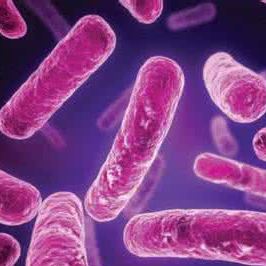
Clostridioides difficile (syn. Clostridium difficile), also known as C. difficile, C.diff, or sometimes CDF/cdf, is a species of Gram-positive spore-forming bacterium.
Clostridioides are anaerobic, motile bacteria, ubiquitous in nature, and especially prevalent in soil. Its vegetative cells are rod shaped, pleomorphic, and occur in pairs or short chains. Under the microscope, they appear as long, irregular (often drumstick- or spindle-shaped) cells with a bulge at their terminal ends (forms subterminal spores). Under Gram staining, C. difficile cells are Gram-positive and show optimum growth on blood agar at human body temperatures in the absence of oxygen. C. difficile is catalase and superoxide dismutase negative, and produces two types of toxins: enterotoxin A and cytotoxin B, which disrupts cytoskeleton signal transductions in the host. When stressed, the bacteria produce spores that are able to tolerate extreme conditions that the active bacteria cannot tolerate.
C. difficile may become established in the human colon; it is present in 2–5% of the adult population.Sometimes antibiotic therapy for various infections has the adverse effect of disrupting the normal balance of the gut microbiota, in which case C. difficile may opportunistically dominate, causing C. difficile infection.
Human pathogen
Pathogenic C. difficile strains produce multiple toxins. The best-characterized are enterotoxin (C.difficile toxin A) and cytotoxin (C. difficile toxin B), both of which may produce diarrhea and inflammation in infected patients (C. difficile colitis), although their relative contributions have been debated. The diarrhea may range from a few days of intestinal fluid loss to life-threatening pseudomembranous colitis. Pseudomembranous colitis is associated with intense inflammation of the colon and formation of pseudomembranes on the intestinal mucosal surface. Toxins A and B are glucosyltransferases that target and inactivate the Rho family of GTPases. Toxin B (cytotoxin) induces actin depolymerization by a mechanism correlated with a decrease in the ADP-ribosylation of the low molecular mass GTP-binding Rho proteins. Another toxin, binary toxin, also has been described, but its role in disease is not fully understood.
In China
According to a meta-analysis of Clostridium difficile infection in Mainland China, the positive rate of toxigenic C. difficile in diarrhoea patients ranged from 3% (Henan Province) to 23% (Hubei Province) , of which the mean rate was 14% (95% CI = 12–16%). ST-35,ST-37,ST-3,ST-54 ,ST-2 were the most prevalent strains, and ST-37 particularly showed a positive correlation with severe clinical C.difficile infections .Hypervirulent strains, such as ST-1 (BI/NAP1/027) and ST-11 (RT 078) , have only occurred sporadically. The rates of C. difficile resistance to ciprofloxacin (98.3%; 95% CI = 96.9–99.7%), clindamycin (81.7%; 95% CI = 76.1–87.3%) and erythromycin (80.2%; 95% CI = 73.5–86.9%) are higher than in other counties. However, none of the C. difficile isolates reported in Mainland China were resistant to metronidazole, vancomycin, tigecycline or piperacillin/ tazobactam.